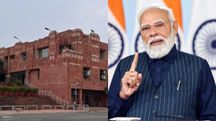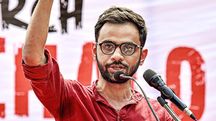Left sweeps JNU Students' Union polls, securing all 4 posts
In a significant electoral outcome, the United Left panel, backed by the Left, has swept the JNUSU elections, marking the election of the first Dalit president from Left-leaning groups in nearly 30 years. The victory symbolizes a rejection of divisive politics and reaffirms faith in their leadership.
 JNUSU elections, United Left panel, Dalit president, student activism, JNU, AISA, DSF, SFI, AISF, Left-leaning groups, voter turnout
JNUSU elections, United Left panel, Dalit president, student activism, JNU, AISA, DSF, SFI, AISF, Left-leaning groups, voter turnoutIn a significant electoral victory, the Left-backed United Left panel secured a clean sweep in the Jawaharlal Nehru University Students' Union (JNUSU) elections, marking the election of the first Dalit president from the Left-leaning groups in nearly three decades.
Dhananjay of the All India Students' Association (AISA) emerged victorious as the JNUSU president, securing 2,598 votes against the Akhil Bharatiya Vidyarthi Parishad's (ABVP) Umesh C Ajmeera, who garnered 1,676 votes. Hailing from Gaya, Bihar, Dhananjay's win represents a significant milestone, being the first Dalit president from the Left since Batti Lal Bairwa's tenure in 1996-97.
Expressing gratitude for the students' support, Dhananjay emphasized that the victory symbolizes a rejection of divisive politics and a reaffirmation of trust in their leadership. He outlined key priorities, including women's safety, fund allocation, scholarship enhancements, and addressing infrastructure and water crises.
Amidst chants of 'Lal Salaam' and 'Jai Bhim', supporters celebrated the triumph of the winning candidates. Avijit Ghosh from the Students' Federation of India (SFI) secured the vice-president's post by defeating ABVP's Deepika Sharma, while Birsa Ambedkar Phule Students' Association (BAPSA) candidate Priyanshi Arya clinched the general secretary position, supported by the Left.
The United Left panel's Mohammad Sajid secured the joint secretary's post, marking a comprehensive victory for the Left bloc. The ABVP, initially leading in all central panel posts, faced stiff competition but ultimately conceded to the Left.
The voter turnout, standing at 73%, marked the highest participation rate in the last 12 years, underscoring the significance of the elections within the JNU community. The United Left panel, comprising AISA, Democratic Students' Federation (DSF), SFI, and the All India Students' Federation (AISF), reinforced JNU's reputation as a stronghold of Left ideology.
With the Left securing all four central panel positions, the JNUSU elections not only reflect the prevailing political landscape within the university but also signify broader trends in student activism and engagement.
Copyright©2026 Living Media India Limited. For reprint rights: Syndications Today









